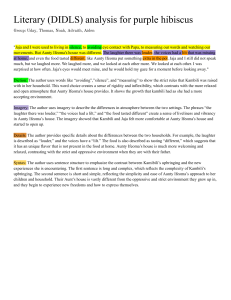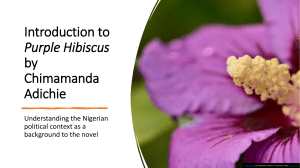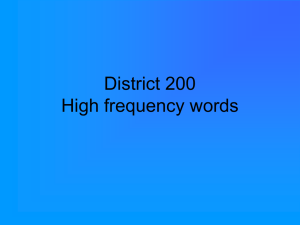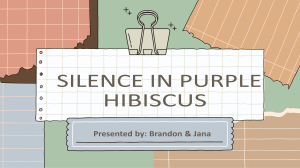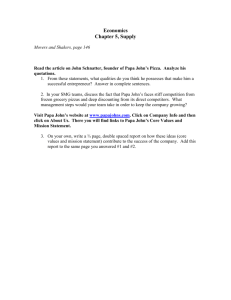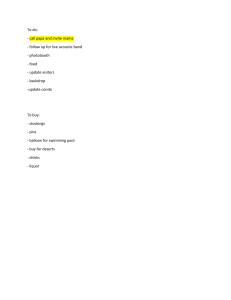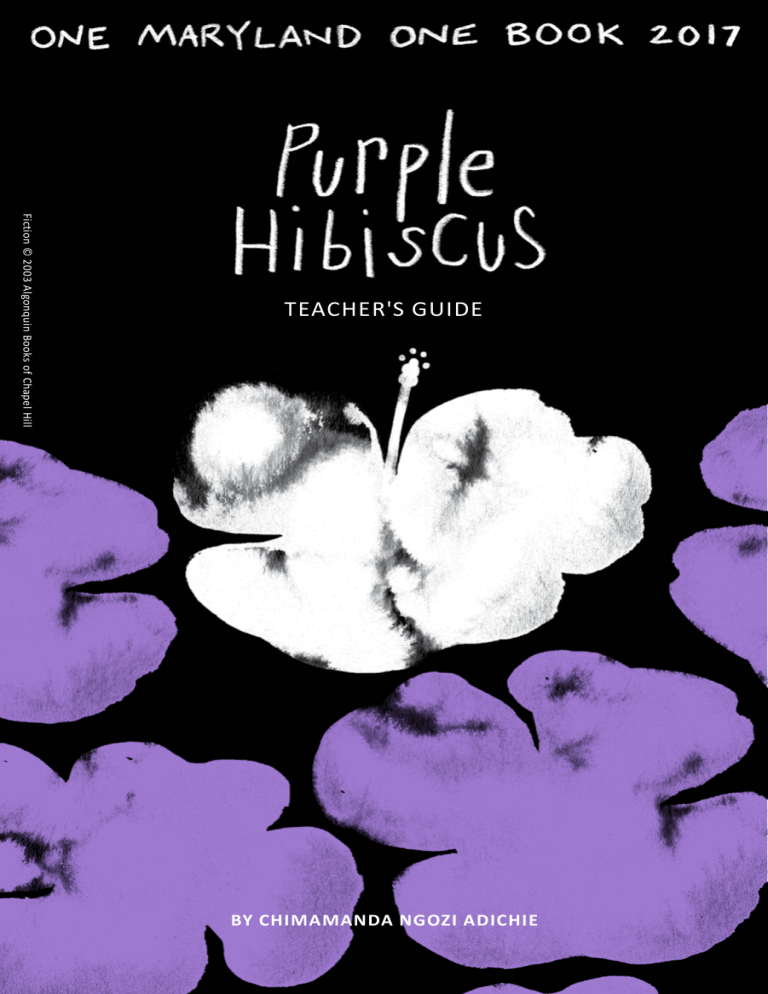
Fiction © 2003 Algonquin Books of Chapel Hill TEACHER'S GUIDE BY CHIMAMANDA NGOZI ADICHIE WHAT IF EVERYONE READ THE SAME BOOK AT THE SAME TIME THEN CAME TOGETHER TO TALK ABOUT IT? When we read a great book, we can’t wait to share the experience and talk about it with others. That’s one of the joys of reading. In this spirit, Maryland Humanities created One Maryland One Book to bring together diverse people in communities across the state through the shared experience of reading the same book. Now in its tenth year, One Maryland One Book remains Maryland’s only statewide community reading program. Each year, the selection process is guided by a theme. The theme for 2017 is “Home and Belonging.” The Maryland Center for the Book at Maryland Humanities partners with public libraries, high schools, colleges and universities, museums, bookstores, correctional facilities, and other organizations to bring bookcentered discussions and other related events to communities across Maryland. But One Maryland One Book is not just about reading or literature; it is also about bringing people together for meaningful dialogue. The book selected for 2017 is Purple Hibiscus by Chimamanda Ngozi Adichie. REACH OUT Each year, more than 10,000 Marylanders read the One Maryland One Book selection. How many of those people are your friends or family? How many are perfect strangers you sit next to on the train or stand in line with at the grocery store? Use the book to jump-start a meaningful conversation with an old friend or to make a new one. PULL UP A CHAIR We invite you to join Maryland Humanities and thousands of Marylanders at one of the many book discussions and related events happening around the state in September and October, including an author tour. To find One Maryland One Book programs in your area, go to www.onemarylandonebook.org and click on Events. For all the latest information, “like” or follow us: facebook.com/MDCenterfortheBook @MDHumanities GRAB YOUR COPY Find a copy of Purple Hibiscus at your local library or bookstore and get reading! What if a copy of Purple Hibiscus finds you? If you’re out and about, you might find copies of the book in unexpected places. Our Wandering Books can be found in a myriad of public spaces from bus stops to county fairs. If you find a copy, it’s yours for a short time. Register the book online so we can see how far it travels (instructions are included inside the book), read it, review it, and then leave it for someone else to find and enjoy. LET TER FROM MARYLAND HUMANITIES BOARD CHAIR AND EXECUTIVE DIRECTOR Look for Chimamanda Ngozi Adichie at several venues in late September, including the Baltimore Book Festival on Sunday, September 24. Thank you for joining Maryland Humanities as we embark on the tenth year of One Maryland One Book, our state’s largest reading and discussion program. Since the program’s launch in 2008, readers across Maryland have embraced our annual tradition of bringing people together from across the state through the reading of one book, selected by a dedicated group of literary enthusiasts. Each year we explore the power of literature with fellow readers—from book clubs at workplaces and libraries to students in high school and college. This shared experience lies at the heart of One Maryland One Book. Whether you’ve read with us every year or are new to the program, welcome! This year’s book offers Marylanders a glimpse into the lives and home of a post-colonial Nigerian family. The first novel by acclaimed author Chimamanda Ngozi Adichie, Purple Hibiscus weaves a gripping tale through the teenage narrator, Kambili, who takes us into the life of a prominent and wealthy Nigerian family with a private secret—a successful and devoutly religious yet physically and psychologically abusive father. While a continent away, the story of Kambili and her family is wretchedly familiar. In the U.S., it’s not difficult for any of us to identify someone we know who has experienced the fear and oppression of abuse. As Kambili comes of age, she and her brother experience respite at their aunt’s house, where there is a freedom and warmth absent under the strict dictates of their father. The contrasts between those homes is striking, but a glimmer of hope remains as the siblings discover more about themselves and about life as the story builds to a dramatic crescendo. We encourage you to pick up a copy of Purple Hibiscus and join the conversation at one of our many public discussion programs across the state. A program of the Maryland Center for the Book at Maryland Humanities, One Maryland One Book is made possible each year through the generosity of our sponsors and community partners. We greatly thank them for their support. Find out how to get involved at www.onemarylandonebook.org. Sincerely, Stephen Sfekas, Board Chair Phoebe Stein, Executive Director 1 ABOUT THE AUTHOR APPLICABLE MARYLAND STATE DEPARTMENT OF EDUCATION COMMON CORE STANDARDS Chimamanda Ngozi Adichie is the leading African writer of her generation. She grew up on the campus of the University of Nigeria, Nsukka, and left Nigeria for the U.S. at the age of 19. RH.11-12.1 Cite specific textual evidence to support analysis of primary and secondary sources, connecting insights gained from specific details to an understanding of the text as a whole. Among her many accolades, Ms. Adichie has been awarded a Hodder fellowship at Princeton University (2005-2006) and a fellowship at the Radcliffe Institute of Harvard University (2011-2012). In 2008, Ms. Adichie earned a coveted MacArthur Genius Award. Ms. Adichie’s work is read around the world, and has been translated into over thirty languages. Her first novel Purple Hibiscus won the Commonwealth Writers’ Prize, and her second novel, Half of a Yellow Sun, won the Orange Prize (now the Bailey’s Women’s Prize), which is the world’s top prize for female writers. Her 2013 novel Americanah has received numerous accolades, including the National Book Critics Circle Award. It was named one of The New York Times Top Ten Best Books of the Year. Ms. Adichie has been invited to speak around the world. Most notably her 2009 TED Talk, The Danger of A Single Story, is now one of the top ten most-viewed TED Talks of all time, with over five millions views. Her 2012 TED talk, We Should All Be Feminists, has a started a worldwide conversation about feminism, especially after it inspired a song by Beyoncé. It was published as a book in 2014. Her most recent book, Dear Ijeawele, or a Feminist Manifesto in Fifteen Suggestions, was published in March 2017. Ms. Adichie is committed to assisting young aspiring writers. As one of her commitments, she leads an annual Writers Workshop in Nigeria, for which applications come from around the world. ABOUT THE BOOK Fifteen-year-old Kambili and her older brother Jaja lead a privileged life in Enugu, Nigeria. They live in a beautiful house, with a caring family, and attend an exclusive missionary school. They’re completely shielded from the troubles of the world. Yet, as Kambili reveals in her tender-voiced account, things are less perfect than they appear. Although her Papa is generous and well respected, he is fanatically religious and tyrannical at home—a home that is silent and suffocating. As the country begins to fall apart under a military coup, Kambili and Jaja are sent to their aunt, a university professor outside the city, where they discover a life beyond the confines of their father’s authority. Books cram the shelves, curry and nutmeg permeate the air, and their cousins’ laughter rings throughout the house. When they return home, tensions within the family escalate, and Kambili must find the strength to keep her loved ones together. Purple Hibiscus is an exquisite novel about the emotional turmoil of adolescence, the powerful bonds of family, and the bright promise of freedom. RH.11-12.2 Determine the central ideas or information of a primary or secondary source; provide an accurate summary that makes clear the relationships among the key details and ideas. RH.11-12.3 Analyze a complex set of ideas or sequence of events and explain how specific individuals, ideas, or events interact and develop over the course of the text. RH.11-12.4 Determine the meaning of words and phrases as they are used in the text, including figurative, connotative, and technical meanings; analyze how an author uses and refines the meaning of a key term or terms over the course of a text. SL.11-12.1 Initiate and participate effectively in a range of collaborative discussions (one-on-one, in groups, and teacher-led) with diverse partners on grades 11-12 topics, texts, and issues, building on others’ ideas and expressing their own clearly and persuasively. SL.11-12.1C Propel conversations by posing and responding to questions that probe reasoning and evidence; ensure a hearing for a full range of positions on a topic or issue; clarify, verify, or challenge ideas and conclusions; and promote divergent and creative perspectives. SL.11-12.3 Evaluate a speaker’s point of view, reasoning, and use of evidence and rhetoric, assessing the stance, premises, links among ideas, word choice, points of emphasis, and tone used. RH.11-12.7 Integrate and evaluate multiple sources of information presented in diverse formats and media (e.g., visually, quantitatively, as well as in words) in order to address a question or solve a problem. SL.11-12.4 Present information, findings, and supporting evidence, conveying a clear and distinct perspective, such that listeners can follow the line of reasoning, alternative or opposing perspectives are addressed, and the organization, development, substance, and style are appropriate to purpose, audience, and a range of formal and informal tasks. RL.1 Cite strong and thorough textual evidence to support analysis of what the text says explicitly as well as inferences drawn from the text. W.11-12.1 Write arguments to support claims in an analysis of substantive topics or texts, using valid reasoning and relevant and sufficient evidence. RL.2 Determine two or more central ideas of a text and analyze their development over the course of the text, including how they interact and build on one another to produce a complex analysis; provide an objective summary of the text. W.11-12.2 Write informative/explanatory texts to examine and convey complex ideas, concepts and information clearly and accurately through the effective selection, organization, and analysis of content. RL.3 Analyze how the author unfolds an analysis or series of ideas or events, including the order in which the points are made, how they are introduced and developed, and the connections that are drawn between them. W.11-12.3 Write narratives to develop real or imagined experiences or events using effective technique, well-chosen details, and well-structured event sequences. RL.4 Determine the meaning of words and phrases as they are used in the text, including figurative and connotative meanings; analyze the impact of specific word choices on meaning and tone, including words with multiple meanings or language that is particularly fresh, engaging, or beautiful. (Include Shakespeare as well as other authors.) RL.6 Determine an author’s point of view or purpose in a text and analyze how an author uses rhetoric to advance that point of view or purpose. W.11-12.4 Produce clear and coherent writing in which the development, organization, and style are appropriate to task, purpose, and audience. W.11-12.6 Use technology, including the Internet, to produce, publish, and update individual or shared writing products in response to ongoing feedback, including new arguments or information. W.11-12.9 Draw evidence from literary or informational texts to support analysis, reflection, and research. 3 SPECIAL NOTES: Teachers and students should be aware that Purple Hibiscus contains scenes of physical and psychological abuse. Teachers may want to prepare students to expect this content and follow up with additional discussion outside of the content offered in this guide as needed. An extensive supplemental guide with additional before and after reading activities; glossary of Igbo words, names, and phrases; and other activities is available online at www.onemarylandonebook.org under How To Participate. We hope that these materials will enhance students’ experience with and understanding of Purple Hibiscus. CHARACTERS: • • • • • • • • • • • • • • • Kambili Achike — Narrator and central character in novel Eugene “Papa” Achike — Kambili and Jaja’s father Beatrice “Mama” Achike — Kambili and Jaja’s mother; wife of Eugene Chukwuka “Jaja” Achike — Kambili’s older brother by about two years Aunty Ifeoma — Eugene’s sister; widowed with three children Amaka — Aunty Ifeoma’s eldest daughter; 15 years old Obiora — Aunty Ifeoma’s son; 14 years old Chima — Aunty Ifeoma’s youngest child; 7 years old Father Amadi — A young, attractive priest; close with Aunty Ifeoma’s family Papa-Nnukwu — Eugene and Ifeoma’s father; rooted in traditional non-Christian beliefs of his indigenous culture Father Benedict — White, British-born head of St. Agnes Church Ade Coker — Editor of newspaper the Standard owned by Papa Achike Yewande Coker — Wife of Ade Coker; has two young children Sisi — Servant girl in the Achikes’ home Kevin — The Achikes’ driver Part I: Geography and Definitions DIRECTIONS: Use your own searching skills to answer the following questions. 1 In what part of Africa is Nigeria located? 2 What are the names of the three ethnic groups that make up the majority of Nigeria’s population? 3 Define the term colonialism. Part II: The Igbo Culture DIRECTIONS: Go to the following website about Igbo culgure: http://www.kwenu.com/igbo/igbowebpages/Igbo.dir/Culture/culture_and_socialization.html Use the information you find there to take notes in the following chart to determine the main characteristics of the Igbo culture in pre-Colonial Nigeria. Use bullet points and put everything in your own words! ELEMENT OF THE IGBO CULTURE NOTES Religion & beliefs Women & family Traditions & rituals Law & justice Part III: Colonization GENERAL THEMES: DIRECTIONS: Go to the following website about colonialism in Africa: Religion, wealth, power, corruption, political instability, effects of violence, personal sacrifice, http://exploringafrica.matrix.msu.edu/students/curriculum/m7b/activity2.php challenges of adolescence Use the information you find there to respond to the following questions. BEFORE READING ACTIVITIES: Visit www.onemarylandonebook.org and click on How To Participate to download this activity in handout format. WEB QUEST: CULTURAL AND HISTORICAL CONTEXT FOR PURPLE HIBISCUS OBJECTIVE: Students will analyze web-based documents in order to determine the causes and effects of colonialism in Africa. DIRECTIONS: Complete the following Web Quest as a way of gaining background knowledge which will help you understand the context and content of the novel we will be studying, Purple Hibiscus. 1 Why did Europeans first go to Africa? 2 What is nationalism? What are some of the negative aspects of nationalism? 3 How did European colonists view themselves? 4 Why did some missionaries support European colonization of Africa? 5 Explain how the following approaches allowed European nations to rule over Africa: Economic Companies: Direct Rule: Indirect Rule: Settler Rule: Part IV: Closing Question DIRECTIONS: Respond to the following question after completing the Web Quest. Based on the background knowledge you acquired today regarding the Igbo culture and European colonization, what conflicts or disagreements do you imagine would have arisen between the two groups (the Igbo and the Europeans) during the period of colonization? What misunderstandings may have occurred between the two groups? 5 Chapter 1 (pages 3-16): • The very first line begins with an allusion to the novel Things Fall Apart by Chinua Achebe, which portrays the clash between Nigeria’s white colonial government and the traditional culture of the indigenous Igbo people. What is the significance of Adichie starting this novel with such an allusion? What mood does it create for the beginning of the story? • The narrator describes the religious traditions her family follows every Palm Sunday. Reread the first paragraph, analyze the significance of the characters who are participating in the traditions of Palm Sunday, and predict what those roles might mean throughout the novel. • The narrator describes her mother’s actions after Papa breaks the figurines and adds imagery of her mother two weeks prior “when her swollen eye was still the black-purple color of an overripe avocado…” (10-11). What can we infer from this description of Kambili’s mother? What can we infer from the casual way Kambili inserts this description? • What is the purpose and effect of the following simile that the narrator uses to describe Jaja’s defiance toward his father: “Jaja’s defiance seemed to me now like Aunty Ifeoma’s experimental purple hibiscus: rare, fragrant with the undertones of freedom, a different kind of freedom from the one the crowds waving green leaves chanted at Government Square after the coup. A freedom to be, to do”? (16). Chapter 2 (pages 19-26): • The paragraph immediately after Kambili and Jaja scrubbing Mama’s blood off of the floor is about an execution that was shown on television. What is the significance of this event and the characters’ reaction to it following what they just witnessed with their parents? • For what, in Papa’s eyes, did Mama need to be forgiven? What is ironic about Papa’s beliefs and his actions? Chapter 4 (pages 37-51): • Why was Ade Coker arrested? What are the implications of his arrest in regards to the Head of State using violence to suppress and discourage free speech? Does suppression of free speech happen in today’s society? Explain. • Adichie uses the rhetorical device anaphora, or the repetition of a word or phrase at the beginning of successive clauses, when she writes “I needed him to touch the back of my neck…” and “I need him to hug me…” and “I needed him to smile at me…” (39). What is the purpose and effect of this device? • What mood does Kambili’s statement, “I was stained by failure,” create for the reader? (39). Have you ever felt this way about yourself? Explain. • How is the theme of perception versus reality reflected through Kambili and her classmates? How is it reflected through the Achike family thus far in the novel? • Because the Igbo are a patriarchal society, marriage holds the utmost significance in order to procreate and continue the family line. However, it is common for a man who has a barren wife to procreate with a woman other than his wife, or even take a second wife. Why is it significant that Mama pointed out Papa’s rejection of other women to her own children? (20). What does the reader learn about Mama’s character through these comments? Chapter 5 (pages 52-70): • What does the reader learn about Kambili’s perception of Mama and Papa’s love for one another? (21). Why is this significant for the reader? • Several times throughout the chapter Papa is called “omelora,” or “The One Who Does for the Community” by the villagers (56). Why is he so revered in Abba? Do you think Papa gains something internally from their admiration? Explain. • The military coups of Nigeria were both successful and unsuccessful since the country’s independence from the British Empire in 1960. The coups discussed in the novel were a permanent feature of Nigerian culture from 1966-1999. What did Papa mean when he stated “But what we Nigerians needed was not soldiers ruling us, what we needed was a renewed democracy”? (25). Chapter 3 (pages 27-36): • Adichie makes it clear in this chapter that Nigeria is now ruled by a military regime, and therefore the soldiers can act with exemption from punishment. How is the theme of freedom versus tyranny illustrated through Kambili’s thoughts and comments in this chapter? • Analyze the impact of the following simile: “Silence hung over the table like the blue-black clouds in the middle of rainy season” (32). What tone does it create and why is it significant? • Kambili describes her determination to be the first in her class as “balancing a sack of gravel” on her head every day at school and “not being allowed to steady it” with her hand (52). What things in your life have you had to balance to achieve something better for yourself? Can you empathize with the pressure Kambili feels she is under? • What is the significance of Papa’s silence when Ade Coker said, “Imagine what the Standard would be if we were all quiet”? (58). • Why are Kambili and Jaja instructed to stay at Papa-Nnukwu’s house for only 15 minutes? What does Papa’s traditionalist father constantly remind him of? • Discuss how the impact of colonialism becomes evident throughout the chapter, including the economic divide between the classes. Chapter 6 (pages 71-88): • Aunty Ifeoma comes to visit and when speaking to Mama, calls her “nwunye m,” or “my wife” (73). Why is it significant that she accepts Mama in such a way? What does Papa’s reaction to that term of endearment tell the reader about his beliefs? 7 • Why is Aunty Ifeoma’s “fearlessness” uncomfortable and forbidding to Kambili? (76). How does Kambili’s outlook about Papa change when Ifeoma is interacting with him? How does she disrupt the order of Papa’s family? • List several examples found throughout the chapter that reflect the economic differences between Papa’s family and Aunty Ifeoma’s family. Why is it important to note these differences? What can the reader infer about Kambili’s views about these differences surrounding her family? • Similar to her classmates, Kambili’s cousin Amaka takes her silence and reserve for privilege and snobbishness. Is there some truth to Amaka’s and her classmates’ assumption? Why is Kambili unable to speak when faced with someone who expresses herself? • Before picking up Papa-Nnukwu to join on the trip to Ezi Icheke, Kambili explains to her aunt that Papa does not want them to have a relationship with their grandfather because he is a pagan, to which Aunty replies that he is “not a pagan,” but a “traditionalist” (81). Research the difference between paganism and traditionalism in the Igbo culture and analyze why it was important for Aunty to clarify the difference. Chapter 7 (pages 89-109): • As Mass ends, Papa donates money to fund the priest’s new house, and after his donation amount is announced, Papa left “smiling and waving at the many hands that reached out to grasp his white tunic as if touching him would heal them of an illness” (91). Analyze the symbolic figure he seems to represent and the irony of this symbolic depiction. • Explain Kambili’s metaphorical statement: “I felt, looking at her, that I was helplessly watching precious flaxen sand slip away between my fingers” (93). What theme does this figurative language develop? • The first revealing example of Papa’s violence occurs when Mama, Jaja, and Kambili are beaten for breaking the Eucharistic fast before church. After the beating, Papa “crushed” Jaja and Kambili into his body to hug them and asked if the “belt hurt” (102). Why does Adichie utilize the word “crushed” to describe a hug? What are other word choices during that violent incident that help create the author’s tone? • Predict what the following statement foreshadows: “Papa called Aunty Ifeoma two days later. Perhaps he would not have called her if we had not gone to confession that day. And perhaps then we would never have gone to Nsukka and everything would have remained the same” (104). • What is the significance of Father Benedict’s eyes being described as “the same green shade of a snake…”? (105). • When Jaja and Kambili discuss wanting to go to Nsukka, why does her throat tighten “at the thought of five days without Papa’s voice, without his footsteps on the stairs”? (108). Chapter 8 (pages 110-139): • What has the reader learned about Kambili thus far through the way she perceives her surroundings and through other people’s views of her? Does the way Kambili narrates the story affect the reader’s perception of Nigeria and the Igbo people? Provide several examples from this chapter for support. • What are some examples of Amaka’s rejection of the Eurocentric colonial mindset? Why might her viewpoint be significant in relation to the previous question? • When Aunty Ifeoma laughed about the schedule Papa gave his children to follow while visiting, Kambili’s “mouth felt dry,” her “tongue clinging to the roof” of her mouth (124). Why does Kambili yearn for the strict order and silence of her home? How do the family dynamics differ in each household, and why are the differences significant? • Why are Aunty Ifeoma’s hibiscuses purple, rather than another color? Of what are they a result? Why is their existence significant to the story thus far? • One of the best-known Nigerian musicians is Fela Ransome Kuti, who Amaka plays for Kambili. Kuti, who was educated in England, created Afrobeat, a style of music that blends jazz with traditional African rhythms. He railed against the colonial mentality of his upbringing and advocated for a return to both traditions and democracy. He was arrested, beaten, and tortured several times for openly criticizing the government. The popularity of his music was seen as a threat to the military establishment. Why is it significant that Amaka listens to this type of music rather than the popular music of the time? Does this make her an activist? (Background and link to his music: http://www.allmusic.com/artist/ fela-kuti-mn0000138833/biography) Chapter 9 (pages 140-161): • What is the opening mood of this chapter, and how is it created by the author? • Aunty Ifeoma suggests that Kambili read a book titled Equiano’s Travels, or the Life of Gustavus Vassa the African (143), also titled The Interesting Narrative and Other Writings by Olaudah Equiano. Research the summary of this novel and then determine why Kambili’s aunt might have chosen this specific text for her to read. • What is the significance of Aunty Ifeoma stating to Jaja “Defiance is like marijuana—it is not a bad thing when it is used right” when discussing the legendary king of ethnic Nigerians Jaja of Opobo? (144). • Aunty Ifeoma covers for Jaja when Chima asks him about his deformed finger (145). However, Kambili wonders how her aunt knows about the incident, and Jaja says when Aunty asked, he told her the truth. What is peculiar about Kambili’s thoughts regarding telling the truth about these situations? Why does she want to remain loyal to her family’s secret? • How is the motif of governmental corruption interspersed throughout this chapter? Cite several examples, then analyze how the lack of a democratic government directly impacts the rights of the people. 9 • When the family is dining with Papa-Nnukwu, Obiora comments that “Morality, as well as the sense of taste, is relative” (156). Knowing Papa-Nnukwu’s beliefs, do you think he agrees with this notion? Would Papa agree with this? Would Mama? Explain your responses for each character. Chapter 10 (pages 162-205): • When describing the lumps of fufu that Aunty Ifeoma uses to “bury” Papa-Nnukwu’s tablets in, the image the narrator uses to compare them to is “spherical coffins” (163). Why is this word choice significant? • After Kambili calls Papa-Nnukwu a heathen again, Aunty Ifeoma wants her to see her grandfather’s rituals and to teach her about his faithfulness to his traditionalist beliefs (167-168). How do Kambili’s views change after watching the full ritual? Explain. • Throughout the novel thus far, Adichie explores the oppressive nature of religion, not only on an individual’s soul, but also on the hypocritical inclinations in religious groups. Although there are many instances of religious compromise and tolerance, some of the characters struggle with their views. Based on what you have read thus far, what stance do the following characters take on organized religion and why? Papa-Nnukwu, Father Amadi, Obiora, Amaka, Aunty Ifeoma, and Papa. • Analyze Kambili’s internal dialogue when she states: “She seemed so happy, so at peace, and I wondered how anybody around me could feel that way when liquid fire was raging inside of me, when fear was mingling with hope and clutching itself around my ankles”(174). • How does the conversation with Father Amadi at the football field open the door for Kambili to question her father’s rules? Cite examples for support. • What is significant about Kambili and Jaja’s reaction to Papa-Nnukwu’s death? Are their reactions expected or unexpected? Chapter 11 (pages 206-216): • After Ade Coker’s assassination, Kambili starts to have violent nightmares (207). What is symbolic about Kambili replacing herself in the nightmare for Ade’s daughter, and her father for Ade? • What does Papa mean when he says there are “fake pastors at those mushroom Pentecostal churches”? (208). What can the reader infer about Papa’s beliefs and his hypocritical nature? • What do Mama’s figurines, Kambili’s painting, and Jaja’s purple hibiscus provide for all three characters in a world of unhinged violence? • What actions and internal dialogue reflect a change in Kambili’s feelings toward her father after the violent incident that almost killed her? Chapter 12 (pages 217-239): • After Kambili and Jaja are sent to Aunty Ifeoma’s so she can heal, Kambili observes several aspects of nature, such as “the smell of freshness in the air” due to rain, and the air “filling with flapping, water-colored wings” (218). Why are her descriptions of nature emphasized in the first few pages of the chapter, given what she has just experienced with her father? • Amaka asks Kambili if it was her father who hurt her and, for the first time, she admits to the truth. Why won’t Kambili look at Amaka to see her reaction to this response? Does Papa still have “control” over her? • Kambili overhears Aunty Ifeoma and her friend discussing the leadership at the university, and Obiora explains, “The university becomes a microcosm of the country” (224). Look up the definition of microcosm and analyze what Obiora means in regards to the spread of tyranny. • Why is Aunty Ifeoma’s house searched? Why is she warned by the special security men to “be careful”? (231). • What is the significance of Jaja killing the chicken with a “precision…a singlemindedness that was cold, clinical”? (235). How has Kambili begun to see her brother? Is their bond as strong as it was in the past? Why or why not? Chapter 13 (pages 240-253): • What larger statement might the author be making about religion in Nigeria in regards to the casual nature of St. Peter’s Catholic Chaplaincy versus the rigidity of Kambili’s Catholic church St. Agnes? Use details of both to support your response. • How is the story about Professor Okafor’s son a lesson about oppression and tyranny? • For the first time in the novel, the reader sees Aunty Ifeoma using violence to reprimand her child (245). Are Aunty Ifeoma and Papa more similar than it seems? Or does this act of violence represent something other than Papa’s forms of discipline? • Mama flees to Aunty Ifeoma’s house after Papa breaks a small table over her belly, killing the fetus Mama was carrying (248), and after Mama speaks with Papa, “she looked like a different woman from the one who had come out of the taxi that morning” (250). Why does Mama continue to make excuses for Papa’s violence? • As they arrive at their home in Enugu, Jaja notes “the purple hibiscuses are about to bloom” (253). What do they symbolize? Why does Jaja mention them right before the flashback to Chapter 1? Chapter 14 (pages 257-270): • Knowing what you learned in Chapter 1 about Palm Sunday, how is the first paragraph contradictory to what the religious day is supposed to represent? (Students might need to do more research about the religious events surrounding Palm Sunday to answer this.) 11 • Why does Papa pay for Ade Coker’s daughter to see the best doctors and therapists in Nigeria and abroad? (259). How is the cause of the daughter’s silence similar to Kambili’s silence throughout the novel? • How have Nigerian politics also “silenced” Aunty Ifeoma? What is significant about the fact that the women in the novel are silenced at some point or another? • Due to Papa’s increasing weakness and loss of familial control, Jaja, Kambili, and Mama all seem to change due to the shift in power. Discuss each of the character’s growing assertions due to the altered family dynamics. • Analyze the significance of the personification of the rain in conjunction with Igbo traditions and beliefs: “It stopped as quickly as it had started, and the sun came out again, mildly, as if yawning after a nap” (266). Chapter 15 (pages 271-287): • Aunty Ifeoma took all of the children and Father Amadi to see the apparition at Aokpe where “a local girl started to see the vision of the Beautiful Woman” (274). How is this renewed religious faith separate from what Kambili was taught by Papa? • Is Kambili’s love for Father Amadi a true love or an immature love? Is it unrequited, or is it squelched for another reason? • It is made clear by the lack of dialogue that Jaja has changed from the beginning of the novel, and how he is stoic about his aunt and cousins leaving for America, as “finality hung in the air, heavy and hollow” (279). What exactly do you believe he is rebelling against? Use examples throughout the text for support. • The last two scenes of this chapter are a joyful, climatic experience with her cousins on top of Odim Hill and the shocking death of her immortal father. Why do you suppose they are juxtaposed with one another? What is the purpose and effect of the juxtaposition of mood? Chapter 16 (pages 288-291): • When Kambili tries to communicate with Jaja through eye contact, they are blank “like a window with its shutter drawn across” (289). Why? • Kambili comments on Jaja’s frustrations about taking care of Mama, and she says “God knows best. God works in mysterious ways,” and then thinks “Papa would be proud that I had said that” (289). Why is she still searching for Papa’s approval, even though he is now gone? • Jaja responds to Kambili’s previous comment and asks “Why did He [God] have to murder his own son so we would be saved? Why didn’t He just go ahead and save us?” (289). What connection is he making between the death of Jesus and his Papa? • Does Jaja suffer more than Kambili throughout the novel? Support your response with examples from the text. Chapter 17 (295-307): • How has Papa’s abuse created “a different silence” that might never be repaired between Jaja, Kambili, and Mama? • Are the updates of the family members and Father Amadi what was to be expected, or do their new lives show the reader things that are unexpected? • Do Jaja’s upcoming release from prison and the death of the Head of State both represent hope for the family and for Nigeria? Or do these events represent a false hope that has been a part of the Achike family for the majority of their lives? • Identify and analyze a passage in the novel that reflects Kambili’s growth in her understanding of her father’s strengths and weaknesses. AFTER READING ACTIVITY: TED TALK “WE SHOULD ALL BE FEMINISTS” • Have students view the following TED Talk by Chimamanda Adichie: “We Should All Be Feminists” (29:28 minutes) https://www.ted.com/talks/chimamanda_ngozi_adichie_we_should_ all_be_feminists PRE-VIEWING: • Define “feminist.” Discuss various responses. DURING VIEWING: • • • • • • Why is the story about being the class leader significant? Why does an African woman tell her that she is “corrupted by Western books?” What type of person is most likely to be a leader? How are the gender roles defined? How do Nigerians define masculinity? How are girls taught to behave in the Nigerian society? What is the language of marriage? AFTER VIEWING: • A journalist gave Adichie advice about being a feminist and told her, “Feminists are women who are unhappy because they cannot find husbands.” How can this advice be disproven by the women in the novel? • What are Adichie’s beliefs about how Nigerians raise their daughters versus their sons? Relate her ideas to how Kambili, Jaja, and their cousins are raised. Support your response with evidence. • What is Adichie’s definition of feminism? Do you agree with her definition? WRIT TEN RESPONSE: • Does Adichie accurately reflect the patriarchal society of Nigeria in Purple Hibiscus? Support your position with examples from the text and the TED Talk. • Does today’s society teach young men to be vulnerable? Did Jaja and Obiroa show their vulnerabilities at times, or did they see them as a weakness? Use examples from the text for support. • Do you agree or disagree with Adichie’s statement, “Culture does not make people; people make culture?” Support your position with real-life examples and examples from the text. 13 Maryland Humanities 108 West Centre Street Baltimore, MD 21201 (410) 685-0095 www.mdhumanities.org The content and resources of this guide were created and compiled by Paige J. Schweitzer. Portions have been reprinted with permission from Algonquin Books of Chapel Hill. One Maryland One Book is sponsored by the Institute of Museum & Library Services via LSTA grant funds received from the Maryland State Library, as well as BGE. Additional support is provided by PNC Foundation, Baltimore City Foundation, Wells Fargo, and M&T Bank. One Maryland One Book is coordinated by the Maryland Center for the Book, a program of Maryland Humanities, in partnership with Enoch Pratt Free Library. Maryland Humanities is an educational nonprofit organization. Our mission is to create and support educational experiences in the humanities that inspire all Marylanders to embrace lifelong learning, exchange ideas openly, and enrich their communities. To learn more, visit www.mdhumanities.org. IN PARTNERSHIP WITH A PROGRAM OF LEAD SPONSORS ADDITIONAL SUPPORT FROM SPONSOR
